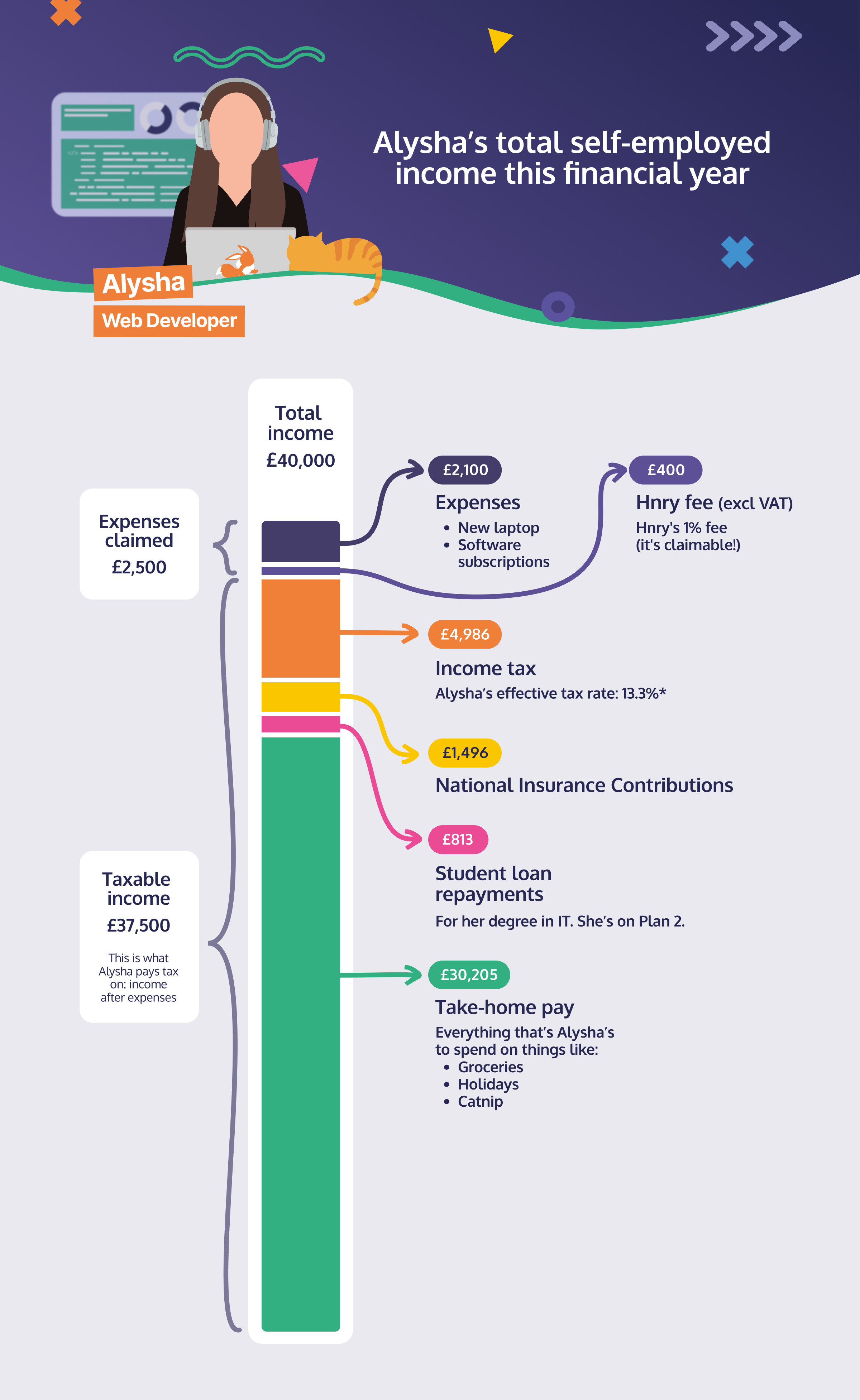As a sole trader, it can be tricky to figure out how much to set aside for your annual tax bill.
That’s why we decided to create a tax calculator that’s specifically for the self-employed.
Enter your:
- sole trader income,
- salary income (if applicable),
- business expenses claimed,
- student loan details,
and get a rough estimate of what you’ll owe HMRC. Easy! 👇
Sole trader tax calculator FY 2025/26
Disclaimer: Please note the numbers shown above are an estimate based on the figures you have provided. If you have any questions, please reach out to the team.
Breakdown of taxes

*An effective tax rate is exactly what it says on the tin: the actual percentage of your total income that you pay in taxes. For more information, check out our guide to tax rates for sole traders.
Key Taxes for the Self-Employed
Income tax
You’re required to pay tax on all your income above the Personal Allowance threshold (£12,570), whether it comes from a salaried job or a self-employment.
HMRC calculates your income tax rate by adding up your earnings from all your sources of income (PAYE/salary jobs, self-employed income, investment income etc) and deducting tax according to our progressive tax rate system.
If you’re a side-hustler, there’s sometimes confusion around why tax is higher on additional income, and how to calculate the amount of tax owed on self-employed earnings – but rest assured, the income tax rates for salaried earners and self-employed individuals are exactly the same.
📖 Still not making sense? We explain calculating taxes in more detail in our guide to tax rates.
VAT
If you earn over £90,000 in a 12-month period in just self-employed income (i.e. not including any PAYE income), you’ll be required to register for and collect VAT.
What this means is that you’ll need to charge customers an additional 20% VAT on top of your regular prices. This 20% is then payable to HMRC whenever you file your VAT returns.
If you make business purchases, the VAT on any business purchase will reduce the amount of the VAT you’ve collected that’s payable to HMRC.
National Insurance Contributions
On top of income tax, you’ll also need to pay National Insurance Contributions (NICs) on your self-employed income. HMRC collects two kinds of NICs from sole traders: Class 2, and Class 4. The exact cost of your NICs will depend on how much you earn in self-employed income
If your profit is below £6,845, your Class 2 contributions will not be treated as having been paid. You can pay voluntary Class 2 contributions however, to avoid a gap in your contributions that may impact potential benefits down the line.
If your profit is between £6,845 and £12,570, your Class 2 contributions will be treated as having been paid. You won’t need to pay Class 4 contributions.
If your profit is above £12,570, your Class 2 contributions will be treated as having been paid. You will, however, need to pay Class 4 contributions on any profit between £12,570 and £50,270 at a rate of 6%, and any profit above £50,270 at a rate of 2%.
💡 HMRC defines Profits as your total self-employed income, minus any business expenses.
If you also earn income from a PAYE job, you’ll already be making NI Contributions as part of your PAYE taxes.
Student loan
If you currently have a student loan, and you’re earning over the repayment threshold for your plan, you’ll need to make repayments on that loan to HMRC.
This applies to your sole trader income, in addition to any repayments you make from a PAYE salary. There’s no way around it, sorry!
The good news is that you only need to pay the repayment percentage on income earned over the threshold. For example, if you’re on plan 1, you’ll only need to pay 9% on every pound earned over the weekly threshold of £501:
| Plan type | Yearly threshold | Monthly threshold | Weekly threshold | Rate of repayment |
|---|---|---|---|---|
| Plan 1 | £26,065 | £2,172 | £501 | 9% |
| Plan 2 | £28,470 | £2,372 | £547 | 9% |
| Plan 4 | £32,745 | £2,728 | £629 | 9% |
| Plan 5 | £25,000 | £2,083 | £480 | 9% |
| Postgraduate Loan | £21,000 | £1,750 | £403 | 6% |
For self-employed earners, HMRC calculates how much you owe based on the income declared in your Self-Assessment. If you’ve been making student loan repayments from a PAYE salary, this will be deducted from the total amount owed.
Not sure which plan you’re on? Sign in to your online account with gov.uk to check.
How Hnry Helps
Hnry is an award winning app and tax service, designed specifically for sole traders. For just 1% +VAT of your self-employed income, capped at £600 +VAT a year, Hnry will calculate and pay all your taxes and whatnot for you, including:
- Income tax
- VAT (if applicable)
- National Insurance Contributions
- Student loan repayments
- Private pension contributions (optional)
We also complete your Self Assessment for you – it’s all part of the service! Better still, using the Hnry platform costs less than using a traditional accountant, and is entirely tax deductible.
If that sounds good to you, join Hnry today and never think about tax again!
Share on:

